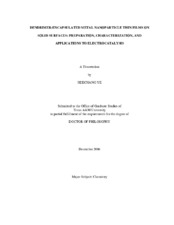| dc.description.abstract | Dendrimer-encapsulated nanoparticles (DENs) were prepared, characterized, and immobilized on solid surfaces. The resulting films were applied as electrocatalysts for the oxygen reduction reaction (ORR). First, the synthesis, physical and chemical properties, and stability of Pd DENs prepared within poly(amidoamine) (PAMAM) dendrimers were studied in aqueous solution. In this part of the study, the following new findings were reported: (1) the maximum Pd ion loading in the dendrimer was correlated to the number of interior amines available for complexation; (2) Pd DENs could be synthesized within amine-terminated Pd DENs by controlling the solution pH; (3) the oxidative stability of Pd DENs was significantly improved by removing solution-phase impurities; (4) exposure to hydrogen gas reversibly converts partially oxidized Pd DENs back to the zerovalent state. Second, Pt and Pd DENs were prepared using amine-terminated PAMAM dendrimers, and then the free amine groups on the periphery were used to immobilize Pt and Pd DENs onto Au surfaces via an intermediate self-assembled monolayer. The resulting DEN films were more robust and had higher coverages of DENs compared to the DEN films prepared via physisorption. Third, Pt DENs were prepared and immobilized on glassy carbon electrodes using an electrochemical coupling method. The resulting films were electrochemically active for the ORR. These electrocatalytic monolayers were also robust, surviving up to 50 consecutive electrochemical scans for ORR and sonication in acid solution with no significant change in activity. Finally, PtPd bimetallic nanoparticles containing an average of 180 atoms (~1.8 nm in diameter) and composed of seven different Pt:Pd ratios were prepared within sixth-generation, hydroxyl-terminated PAMAM dendrimers. Transmission electron microscopy and single-particle energy dispersive spectroscopy confirmed the sizes and compositions of the particles. These DENs were immobilized on glassy carbon electrodes, and their electrocatalytic properties were evaluated as a function of composition using cyclic voltammetry and rotating disk voltammetry. The results showed that the maximum rate for the ORR occurs at a Pt:Pd ratio of 5:1, which corresponds to a relative mass activity enhancement of 2.5 compared to otherwise identical monometallic Pt nanoparticles. | en |


